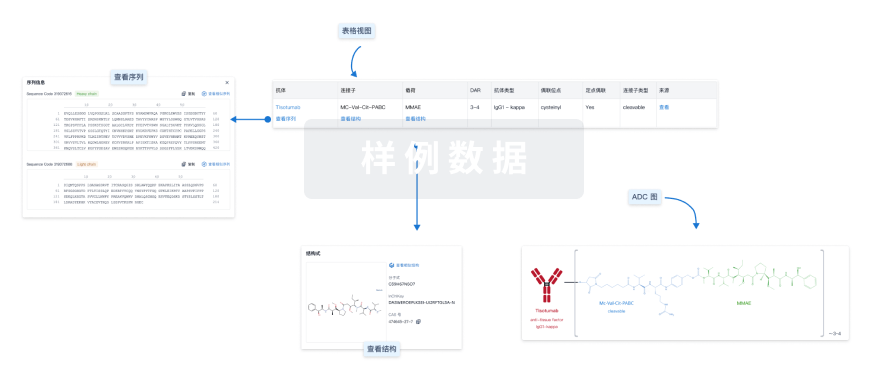预约演示
更新于:2025-12-14
Ulintoclax pegondrimer
更新于:2025-12-14
概要
基本信息
原研机构 |
非在研机构 |
最高研发阶段临床阶段不明 |
首次获批日期- |
最高研发阶段(中国)- |
特殊审评- |
登录后查看时间轴
结构/序列
使用我们的ADC技术数据为新药研发加速。
登录
或

关联
3
项与 Ulintoclax pegondrimer 相关的临床试验NCT05205161
A Modular Phase I/II, Open-label, Dose Escalation and Expansion, Multicentre Study to Assess the Safety, Tolerability, Pharmacokinetics, and Preliminary Efficacy of AZD0466 as Monotherapy or in Combination With Anticancer Agents in Patients With Advanced Non-Hodgkin Lymphoma.
This study evaluates the safety, tolerability, PK, and preliminary efficacy of AZD0466 as monotherapy or in combination with other anticancer agents in patients with advanced NHL
开始日期2022-07-05 |
申办/合作机构 |
NCT04865419
A Modular Phase I/II, Open-Label, Multi-Centre Study to Assess the Safety, Tolerability, Pharmacokinetics and Preliminary Efficacy of AZD0466 Monotherapy or in Combination in Patients With Advanced Haematological Malignancies
The purpose of the study is to the evaluate safety, tolerability, pharmacokinetics (PK), and efficacy of AZD0466 as monotherapy in partciapants with advanced haematological malignancies and also to assess drug-drug interaction (DDI) potential between AZD0466 and the azole antifungal voriconazole.
开始日期2021-06-11 |
申办/合作机构 |
NCT04214093
A Phase I, Open-Label, Multicenter Study to Assess the Safety, Tolerability, Pharmacokinetics and Preliminary Antitumor Activity of Ascending Doses of AZD0466 in Patients With Advanced Hematologic or Solid Tumors
This is a first-time-in-human (FTIH), Phase 1 study to determine the safety, tolerability, maximum tolerated dose (MTD), recommended Phase 2 dose (RP2D), and pharmacokinetics (PK) of AZD0466 in patients with solid tumors, lymphoma and multiple myeloma at low risk for tumor lysis syndrome (TLS), as well as in patients at intermediate risk or high risk of TLS with hematologic malignancies for whom no standard therapy exists. Once an MTD/RP2D has been determined in the dose escalation portion, further disease-specific expansions (solid tumor and hematologic) will be undertaken. Combinations of AZD0466 with other standard of care treatments may be evaluated in the future.
开始日期2019-12-16 |
申办/合作机构 |
100 项与 Ulintoclax pegondrimer 相关的临床结果
登录后查看更多信息
100 项与 Ulintoclax pegondrimer 相关的转化医学
登录后查看更多信息
100 项与 Ulintoclax pegondrimer 相关的专利(医药)
登录后查看更多信息
8
项与 Ulintoclax pegondrimer 相关的文献(医药)2025-02-11·Blood Advances
Antileukemia efficacy of the dual BCL2/BCL-XL inhibitor AZD0466 in acute lymphoblastic leukemia preclinical models
Article
作者: Cidado, Justin ; Yoshimura, Satoshi ; Andersen, Courtney L. ; Kannan, Sankaranarayanan ; Jain, Nitin ; Baran, Natalia ; Yang, Jun J. ; Yang, Xu ; Yu, Jiyang ; Hsiao, YuChih ; Li, Zhenhua ; Balachander, Srividya ; Li, Yizhen ; Zhang Tatarata, Qi ; Ghotbaldini, Sanaz ; Konopleva, Marina
Abstract:
The upregulation of B-cell lymphoma 2 (BCL2) and B-cell lymphoma–extra large (BCL-XL), 2 proteins in the BCL2 family of proteins, leads to a disproportional expression of prodeath and prosurvival proteins in favor of leukemia survival, tumorigenesis, and chemoresistance. In different subsets of acute lymphoblastic leukemia (ALL), the proportion of these 2 proteins varies, and their potential as therapeutic targets needs detailed characterization. Here, we investigated BCL2 and BCL-XL, the genes that encode BCL2 and BCL-XL, and their expression differences between B-cell acute lymphoblastic leukemia (B-ALL) and T-cell ALL (T-ALL). We also evaluated the therapeutic potential of targeting these proteins with AZD0466, a novel drug-dendrimer conjugate of the BCL2/BCL-XL inhibitor AZD4320, and with BCL2 inhibitor venetoclax (ABT-199). Gene expression and activity analyses supported by the protein expression patterns in ALL cell lines and primary samples demonstrated increased levels of BCL2 expression in B-ALL, with high sensitivity to venetoclax or AZD4320. In contrast, strong BCL-XL expression and sensitivity to dual BCL2/BCL-XL inhibition was observed specifically in T-ALL samples. This observation was confirmed by BH3 profiling, demonstrating BCL2/BCL-XL codependence in T-ALL and BCL2 dependence in B-ALL. In a mouse model of T-ALL, AZD0466 but not venetoclax reduced leukemic burden and prolonged survival without significant toxicities. Our findings therefore suggest that the novel dual BCL2/BCL-XL inhibitor AZD0466 outperforms single BCL2 inhibition by venetoclax in T-ALL. These findings facilitate the translation of dual BCL2/BCL-XL inhibitors into ALL clinical trials, either alone or in combination with standard-of-care chemotherapy and immune therapies.
2023-04-01·International journal of pharmaceutics
In depth characterization of physicochemical critical quality attributes of a clinical drug-dendrimer conjugate
Article
作者: Owen, David ; Jackman, Mark ; Even Borgos, Sven ; Li, Weimin ; Hyldbakk, Astrid ; Calzolai, Luigi ; Mahmoudi, Najet ; Treacher, Kevin ; Mehn, Dora ; Ashford, Marianne ; Jayne Lawrence, M ; Akhtar, Nadim ; Sonzini, Silvia ; Caputo, Fanny ; Patterson, Claire
A deep and detailed understanding of drug-dendrimer conjugates key properties is needed to define the critical quality attributes that affect drug product performance. The characterization must be executed both in the formulation media and in biological matrices. This, nevertheless, is challenging on account of a very limited number of suitable, established methods for characterizing the physicochemical properties, stability, and interaction with biological environment of complex drug-dendrimer conjugates. In order to fully characterize AZD0466, a drug-dendrimer conjugate currently under clinical development by AstraZeneca, a collaboration was initiated with the European Nanomedicine Characterisation Laboratory to deploy a state-of-the-art multi-step approach to measure physicochemical properties. An incremental complexity characterization approach was applied to two batches of AZD0466 and the corresponding dendrimer not carrying any drug, SPL-8984. Thus, the aim of this work is to guide in depth characterization efforts in the analysis of drug-dendrimer conjugates. Additionally, it serves to highlight the importance of using the adequate complementary techniques to measure physical and chemical stability in both simple and biological media, to drive a complex drug-dendrimer conjugate product from discovery to clinical development.
2023-03-01·Journal of pharmaceutical sciences
The Global Characterisation of a Drug-Dendrimer Conjugate - PEGylated poly-lysine Dendrimer
Article
作者: Wren, Stephen ; Coombes, Steve ; McCormick, Marc ; Whittaker, Dave ; Mahmoudi, Najet ; Hughes, Leslie P ; Ray, Andrew ; Treacher, Kevin E ; Ngeny, Maryann ; Beer, Louisa ; Jackman, Mark ; Bristow, Tony ; Bowes, Alex ; Holman, Stephen W ; Li, Weimin ; Tang, Yayan ; Poulton, Andy ; Sanderson, Natalie ; Cross, Rebecca ; Lee, Jessica ; Eriksson, Emma ; Sonzini, Silvia ; Broo, Anders ; MacMillan, Bryce ; Newling, Ben ; Buttar, David ; Lawrence, M Jayne ; Ashford, Marianne B ; Linke, Rebecca ; Patterson, Claire ; Guilbaud, Jean-Baptiste ; Akhtar, Nadim
The recent emergence of drug-dendrimer conjugates within pharmaceutical industry research and development introduces a range of challenges for analytical and measurement science. These molecules are very high molecular weight (100-200kDa) with a significant degree of structural complexity. The characteristics and quality attributes that require understanding and definition, and impact efficacy and safety, are diverse. They relate to the intact conjugate, the various building blocks of these complex systems and the level of the free and bound active pharmaceutical ingredient (API). From an analytical and measurement science perspective, this necessitates the measurement of the molecular weight, impurity characterisation, the quantitation of the number of conjugated versus free API molecules, the determination of the impurity profiles of the building blocks, primary structure and both particle size and morphology. Here we report the first example of a global characterisation of a drug-dendrimer conjugate - PEGylated poly-lysine dendrimer currently under development (AZD0466). The impact of the wide variety of analytical and measurement techniques on the overall understanding of this complex molecular entity is discussed, with the relative capabilities of the various approaches compared. The results of this study are an essential platform for the research and development of the future generations of related dendrimer-based medicines.
5
项与 Ulintoclax pegondrimer 相关的新闻(医药)2025-12-12
凋亡调控的史诗:BCL-2家族的发现、机制演进与临床革命(1978-2025) (接前文“三、深化:机制的精细解析与模型迭代(2001-2010)”) 四、转化:靶向BCL-2家族药物的研发与临床突破(2011-2019) 2010年后,BCL-2家族的研究正式迈入“临床转化黄金期”。此前30年的机制积累——从BCL-2基因的克隆、三大亚家族网络的构建,到MOMP细节与动态平衡模型的完善,终于为靶向药物研发提供了清晰的“路线图”:核心靶点聚焦抗凋亡蛋白(BCL-2、BCL-XL、MCL-1),研发思路围绕“模拟BH3结构域、竞争性结合抗凋亡蛋白疏水沟槽”展开,即“BH3模拟物”。这十年的核心叙事,是“从失败中找规律”——早期BH3模拟物因毒性、耐药问题折戟,科学家通过优化分子结构、精准选择适应症,最终推动全球首个BCL-2抑制剂维奈克拉(Venetoclax)获批上市,实现“靶向凋亡治疗”从理论到临床的跨越;同时,针对单靶点抑制剂的耐药困境,双靶点抑制剂的研发也逐步进入临床探索阶段,为后续治疗升级奠定基础。 4.1 早期探索:BH3模拟物的“试错与教训”(2011年前铺垫与2011-2013年突破前) 事实上,早在1996年BCL-XL晶体结构解析后,科学家就已启动BH3模拟物研发,但早期探索充满挫折,核心问题集中在“靶点选择性差”与“毒性不可控”,这也为后续维奈克拉的成功积累了关键经验。 4.1.1 首个临床候选药物:ABT-737的“希望与局限” 2005年,雅培公司(后拆分出艾伯维)研发团队基于BCL-XL的疏水沟槽结构,设计出首个高亲和力BH3模拟物——ABT-737,这是BH3模拟物研发的“里程碑起点”。体外实验显示,ABT-737可特异性结合BCL-2、BCL-XL、BCL-W(对MCL-1、A1无亲和力),结合亲和力与内源性BIM相当,能有效竞争性解除其对BAX/BAK的抑制,在淋巴瘤、白血病细胞系中诱导凋亡,IC50(半数抑制浓度)低至纳摩尔级(nM);动物实验中,ABT-737联合化疗可显著缩小滤泡性淋巴瘤、慢性淋巴细胞白血病(CLL)的移植瘤,延长小鼠生存期。 2008年,ABT-737进入I期临床试验,针对复发/难治性血液瘤患者,但很快暴露出两大致命局限:① 药代动力学缺陷:ABT-737是脂溶性小分子,口服生物利用度极低(<5%),仅能通过静脉注射给药,且半衰期短(约2小时),需频繁给药,患者依从性差;② 严重毒性:因同时抑制BCL-XL,而BCL-XL是血小板存活的关键蛋白(血小板中几乎无BCL-2,依赖BCL-XL维持存活),ABT-737治疗后患者均出现剂量依赖性血小板减少(血小板计数最低降至正常下限的10%以下),且伴随严重出血风险,即使降低剂量,毒性仍无法耐受,最终ABT-737止步于II期临床试验。 ABT-737的失败虽令人惋惜,却为后续研发指明了方向:一是需优化分子结构,提升口服生物利用度;二是必须提高靶点选择性——若能研发“仅抑制BCL-2,不抑制BCL-XL/MCL-1”的选择性抑制剂,即可规避血小板减少毒性,同时精准针对依赖BCL-2存活的肿瘤(如CLL、滤泡性淋巴瘤)。 4.1.2 二代优化产物:ABT-263(Navitoclax)的“进步与妥协” 基于ABT-737的教训,艾伯维团队对分子结构进行改造:在ABT-737的核心骨架上增加水溶性基团,提升口服生物利用度;同时微调BH3模拟区域的氨基酸侧链,降低对BCL-XL的亲和力。2010年,二代BH3模拟物ABT-263(商品名Navitoclax,纳维托克)诞生,其药代动力学与毒性均较ABT-737显著改善:口服生物利用度提升至30%-40%,半衰期延长至12小时,可每日口服一次;对BCL-XL的亲和力较ABT-737下降10倍,血小板减少毒性有所减轻(II期临床试验中,3级以上血小板减少发生率从ABT-737的100%降至60%)。 2011-2013年,ABT-263开展多项II期临床试验,在复发/难治性CLL患者中表现出亮眼疗效:单药治疗的客观缓解率(ORR)达47%,其中部分患者(约15%)达到完全缓解(CR),且缓解持续时间(DoR)中位数达11个月,这是首次在临床中证实“靶向BCL-2可有效诱导肿瘤细胞凋亡”。但遗憾的是,ABT-263仍未完全解决BCL-XL相关毒性——即使亲和力下降,仍有30%患者因严重血小板减少(伴脑出血、消化道出血)停药,且在实体瘤临床试验中(如非小细胞肺癌),除血小板减少外,还出现剂量依赖性中性粒细胞减少,限制了其剂量提升与广泛应用。最终,ABT-263仅在部分国家获批用于“特定复发/难治性血液瘤”(如美国仅获批用于伴17p缺失的高危CLL),未成为广谱抗癌药物。 ABT-737与ABT-263的探索,本质是“靶点选择性与疗效平衡”的试错——两者的经验证明,“泛抗凋亡蛋白抑制剂”因毒性问题难以推广,“高选择性抑制剂”才是未来研发的核心方向;同时也明确了“BCL-2是血液瘤中的优质靶点”,尤其对依赖BCL-2存活的CLL、淋巴瘤,靶向BCL-2的疗效明确,只需解决毒性问题,即可实现临床突破。 4.2 里程碑突破:维奈克拉(Venetoclax)的研发与临床成功(2014-2019) 2014年,艾伯维团队基于前两代药物的经验,完成了BH3模拟物的“精准迭代”——推出全球首个高选择性BCL-2抑制剂维奈克拉(Venetoclax,商品名Venclexta,维奈托克)。其核心创新是“极致的靶点选择性”:通过分子结构的精细优化(在ABT-263基础上增加刚性环结构),使维奈克拉对BCL-2的结合亲和力较BCL-XL高1000倍以上,对MCL-1几乎无亲和力,彻底规避了BCL-XL相关的血小板减少毒性,同时精准靶向BCL-2依赖型肿瘤,最终在临床试验中大放异彩,于2016年获批上市,开启“靶向凋亡治疗”的临床时代。 4.2.1 分子设计核心:“刚性环”实现靶点精准锁定 维奈克拉的分子设计突破,源于对BCL-2与BCL-XL疏水沟槽结构差异的深度解析。结构生物学研究发现,BCL-2的疏水沟槽底部存在一个独特的“甘氨酸残基(Gly101)”,而BCL-XL对应位置是“丙氨酸残基(Ala94)”——甘氨酸的侧链仅为一个氢原子,空间位阻远小于丙氨酸(侧链为甲基)。基于这一差异,研发团队在维奈克拉的核心骨架上增加了一个“刚性苯并恶唑环”,该环的大小恰好可嵌入BCL-2因Gly101形成的“空间空位”,与BCL-2形成特异性氢键结合,大幅提升亲和力;而BCL-XL因Ala94的空间位阻,无法容纳该刚性环,导致维奈克拉与BCL-XL的结合亲和力显著下降(仅为BCL-2的1/1000),从而实现“精准靶向BCL-2,排除BCL-XL”的目标。 体外实验验证显示,维奈克拉对BCL-2的IC50仅为0.01nM,对BCL-XL的IC50则超过10nM,选择性较ABT-263提升100倍;在血小板中,因几乎无BCL-2表达(依赖BCL-XL存活),维奈克拉即使在高浓度(100nM)下,也不会诱导血小板凋亡,从分子层面彻底解决了前两代药物的核心毒性问题。 4.2.2 临床试验:从血液瘤起步,逐步拓展适应症 2014年起,维奈克拉开展了覆盖多种血液瘤的I-III期临床试验,核心聚焦“BCL-2依赖型肿瘤”(如CLL、急性髓系白血病AML、滤泡性淋巴瘤FL),临床试验结果均超出预期,尤其在高危CLL和老年AML患者中,打破了传统治疗的疗效瓶颈。 - 适应症1:复发/难治性慢性淋巴细胞白血病(R/R CLL)——高危患者的“救命药”CLL是最依赖BCL-2的血液瘤之一,约80%的CLL患者存在BCL-2高表达,且高危CLL(如伴17p缺失、TP53突变)对传统化疗(如氟达拉滨)耐药,预后极差,5年生存率不足20%。2016年,维奈克拉针对R/R CLL的II期临床试验(M13-982研究)结果发表于《New England Journal of Medicine》,数据显示:- 总客观缓解率(ORR)达79.4%,其中完全缓解(CR)率19.2%,部分缓解伴淋巴细胞增多(PR-L)率53.1%;- 针对伴17p缺失的高危患者(传统化疗ORR<10%),维奈克拉单药ORR达77%,CR率15%,缓解持续时间(DoR)中位数达30个月;- 安全性方面,3级以上血小板减少发生率仅为11%,无严重出血事件,彻底解决了前两代药物的毒性问题。基于该数据,美国FDA于2016年4月加速批准维奈克拉用于“伴17p缺失的R/R CLL”,成为全球首个获批的靶向BCL-2的抗癌药物。 随后,2018年公布的III期临床试验(CLL14研究)进一步将维奈克拉的适应症拓展至“初治CLL”,尤其针对老年患者(≥70岁)或无法耐受化疗的患者:维奈克拉联合抗CD20单抗(奥比妥珠单抗),对比传统方案(苯丁酸氮芥联合奥比妥珠单抗),中位无进展生存期(PFS)从19个月延长至“未达到”(随访2年时,联合组PFS率达88%,传统组仅为64%),CR率从7%提升至30%,且3级以上不良反应发生率更低(41% vs 63%)。2019年,FDA批准维奈克拉联合奥比妥珠单抗用于初治CLL,使其成为CLL一线治疗的核心方案之一。 - 适应症2:初治老年急性髓系白血病(AML)——打破“无药可用”困境AML是老年血液系统恶性肿瘤,≥75岁的初治AML患者因身体机能差,无法耐受强化化疗,传统治疗(如低剂量阿糖胞苷)的ORR仅为25%-30%,中位生存期不足6个月,几乎处于“无药可用”状态。而AML患者中,约50%存在BCL-2高表达,且老年患者常伴随MCL-1表达相对较低,对维奈克拉敏感。 2018年,维奈克拉联合低剂量阿糖胞苷(LDAC)的I/II期临床试验(NCT02287233)结果发表于《Nature Medicine》,数据显示: - 初治老年AML患者(中位年龄76岁)的ORR达60%,其中CR率37%,部分缓解伴骨髓恢复(CRi)率23%;- 中位生存期从传统方案的5.5个月延长至10.1个月,1年生存率从24%提升至43%;- 安全性方面,主要不良反应为中性粒细胞减少性发热(3级以上发生率42%),可通过粒细胞集落刺激因子(G-CSF)和抗生素控制,无严重血小板减少或出血风险。2018年11月,FDA加速批准维奈克拉联合LDAC用于“≥75岁初治AML”或“无法耐受强化化疗的初治AML”,首次将靶向BCL-2治疗拓展至AML领域,为老年AML患者带来新希望。- 适应症3:复发/难治性滤泡性淋巴瘤(R/R FL)——补充治疗新选择FL是BCL-2家族发现的“起源肿瘤”(t(14;18)易位导致BCL-2高表达),传统治疗(如R-CHOP方案)后复发率高,且复发后疗效逐步下降。2019年,维奈克拉单药治疗R/R FL的II期临床试验(NCT01889185)结果显示,ORR达47%,CR率13%,中位DoR达14个月,且安全性良好(3级以上不良反应发生率34%,主要为中性粒细胞减少)。基于该数据,欧洲EMA批准维奈克拉用于R/R FL,进一步扩大了其适应症范围。 4.2.3 临床应用关键:“剂量爬坡”规避肿瘤溶解综合征(TLS) 维奈克拉虽毒性低,但作为强效凋亡诱导剂,在治疗初期(尤其是CLL患者),因大量肿瘤细胞快速凋亡,会释放大量核酸、钾、磷等物质,可能引发“肿瘤溶解综合征(TLS)”——这是一种致命性不良反应,表现为高钾血症、高磷血症、低钙血症、急性肾衰竭,若不预防,发生率可达10%-15%。 为规避这一风险,临床中制定了严格的“剂量爬坡方案”:治疗第1周每日20mg,第2周每日50mg,第3周每日100mg,第4周每日200mg,第5周起每日400mg(CLL标准剂量),若患者存在高肿瘤负荷(如淋巴结直径>5cm、外周血淋巴细胞计数>25×10⁹/L),则需延长爬坡时间(如第1周10mg,第2周20mg),同时在治疗前3天给予别嘌醇(降低尿酸)、静脉补液(促进代谢产物排出),治疗初期每日监测血常规、电解质和肾功能,使TLS发生率降至1%以下,确保用药安全。这一“剂量爬坡”策略,也成为后续所有强效凋亡诱导剂临床应用的“标准流程”。 4.3 现实挑战:单靶点抑制剂的耐药机制与应对探索(2017-2019) 维奈克拉的成功,验证了靶向BCL-2的有效性,但临床应用中很快发现,部分患者会出现耐药,尤其在AML和晚期淋巴瘤中,耐药发生率可达30%-40%,成为制约疗效的新瓶颈。2017-2019年,科学家通过临床样本分析与机制研究,明确了维奈克拉耐药的核心机制,同时启动了“耐药应对策略”的临床探索,为后续药物研发指明方向。 4.3.1 核心耐药机制:MCL-1代偿性高表达与BCL-2突变 通过对维奈克拉耐药患者的肿瘤样本进行基因测序、蛋白表达检测,结合体外耐药细胞系研究,发现耐药机制主要集中在两大方向,均与“抗凋亡蛋白代偿”或“靶点结构改变”相关: - 机制1:MCL-1代偿性高表达——最主要的耐药原因(占比60%以上)根据“动态平衡模型”,抗凋亡蛋白间存在代偿效应,当BCL-2被维奈克拉抑制后,若MCL-1表达升高,可替代BCL-2结合BIM/PUMA,继续抑制BAX/BAK,从而逃避凋亡。临床研究发现,维奈克拉耐药患者中,约65%存在MCL-1蛋白水平升高,升高原因主要有两种:- 降解受阻:肿瘤细胞中GSK3β突变或β-TRCP缺失(前文3.2.2),导致MCL-1无法被磷酸化和K48型泛素化,降解受阻,蛋白水平异常升高;- 转录激活:细胞因子(如IL-6)或通路激活(如MAPK-ERK通路突变),促进MCL-1转录,蛋白合成增加。体外实验证实,若在维奈克拉耐药细胞系中通过siRNA沉默MCL-1,可恢复细胞对维奈克拉的敏感性,IC50从耐药后的100nM降至敏感时的1nM,证实MCL-1代偿是耐药的核心。- 机制2:BCL-2基因突变——靶点结构改变导致药物结合失效(占比20%-25%)维奈克拉的结合依赖BCL-2疏水沟槽的Gly101残基,若BCL-2基因发生突变,导致Gly101被其他氨基酸替代,会破坏维奈克拉的结合位点,使药物无法与BCL-2结合。临床中最常见的突变是“BCL-2 G101V突变”(占突变类型的70%),Gly101变为缬氨酸(Val)后,侧链为异丙基,空间位阻大幅增加,维奈克拉的刚性环无法嵌入疏水沟槽,结合亲和力下降1000倍以上,彻底失去抑制活性。此外,还存在BCL-2 A113V、D103Y等突变,均通过改变疏水沟槽结构,导致药物结合失效。 4.3.2 耐药应对策略:MCL-1抑制剂联合与双靶点抑制剂研发 针对上述耐药机制,科学家启动了两种应对策略的临床探索,均以“同时抑制BCL-2与MCL-1”为核心,打破抗凋亡蛋白代偿: - 策略1:维奈克拉联合MCL-1抑制剂——“联合用药”快速破局既然MCL-1代偿是主要耐药原因,最直接的策略是“维奈克拉+MCL-1抑制剂”联合,同时抑制两大抗凋亡蛋白,彻底打破平衡。2017年起,多款MCL-1抑制剂(如S64315、AMG-397)进入I/II期临床试验,与维奈克拉联合用于耐药患者:- 维奈克拉联合S64315(MCL-1抑制剂):在维奈克拉耐药的AML患者中,ORR达40%,其中CR率15%,中位DoR达6个月,且无新增严重毒性(主要不良反应为中性粒细胞减少,发生率38%);- 维奈克拉联合AMG-397:在维奈克拉耐药的CLL患者中,ORR达35%,CR率10%,证实“BCL-2+MCL-1”联合抑制可有效逆转耐药。- 策略2:BCL-2/MCL-1双靶点抑制剂——“单药双抑”简化方案联合用药虽有效,但存在“药物相互作用”“不良反应叠加”等问题,因此研发“同时抑制BCL-2与MCL-1的双靶点抑制剂”成为更优选择。2018-2019年,多款双靶点抑制剂(如APG-2575、AZD-4320)完成临床前研究,进入I期临床试验:- 体外实验显示,APG-2575对BCL-2的IC50为0.05nM,对MCL-1的IC50为0.5nM,选择性均较高(对BCL-XL的IC50>10nM),可同时抑制BCL-2与MCL-1,在维奈克拉耐药细胞系中,IC50低至0.1nM,显著优于维奈克拉单药;- I期临床试验中,APG-2575单药治疗R/R AML患者,ORR达50%,其中CR率25%,且3级以上血小板减少发生率仅为8%,安全性良好,为耐药患者提供了“单药治疗”的新选择。 4.4 其他靶点探索:BCL-XL与MCL-1抑制剂的研发进展(2011-2019) 在维奈克拉聚焦BCL-2靶点的同时,针对BCL-XL与MCL-1的抑制剂研发也在同步推进,虽因毒性或技术难题,进展慢于BCL-2抑制剂,但也取得了阶段性突破,为后续多靶点联合治疗提供了补充。 4.4.1 BCL-XL抑制剂:毒性难题的“部分突破” BCL-XL在多种实体瘤(如非小细胞肺癌、结直肠癌)和血液瘤(如套细胞淋巴瘤)中高表达,是重要靶点,但因血小板减少毒性,研发难度极大。2015年后,科学家通过两种策略降低毒性,推动BCL-XL抑制剂进入临床: - 策略1:“组织特异性”抑制剂——仅在肿瘤组织中激活研发团队设计出“前药形式”的BCL-XL抑制剂(如DT2216),该药物在正常组织(如骨髓)中处于无活性状态,进入肿瘤组织后,被肿瘤特异性高表达的蛋白酶(如基质金属蛋白酶MMP-9)切割,释放出活性形式的BCL-XL抑制剂,从而选择性抑制肿瘤中的BCL-XL,减少对血小板的损伤。2019年,DT2216的I期临床试验显示,在非小细胞肺癌患者中,ORR达30%,3级以上血小板减少发生率仅为12%,较ABT-263显著降低,证实“组织特异性激活”策略可有效规避毒性。- 策略2:“短期给药”方案——减少对血小板的持续损伤BCL-XL抑制剂导致的血小板减少是“可逆性”的(停药后血小板可快速恢复,因血小板半衰期仅7-10天),因此研发团队设计“短期给药”方案:每周给药1次(如BCL-XL抑制剂AZD-0466,每周口服1次),给药后血小板暂时下降,停药期间快速恢复,避免持续抑制导致的严重出血。2018年,AZD-0466的I期临床试验显示,在套细胞淋巴瘤患者中,ORR达45%,3级以上血小板减少发生率为20%,且均为可逆性,无严重出血事件。 4.4.2 MCL-1抑制剂:技术难题的“逐步攻克” MCL-1的疏水沟槽结构更灵活,且与BIM的结合亲和力极高(是BCL-2与BIM结合亲和力的10倍),传统BH3模拟物难以竞争性结合,因此MCL-1抑制剂研发的核心难题是“提升结合亲和力”。2016年后,通过结构生物学与计算机辅助药物设计(CADD)的结合,科学家终于突破技术瓶颈,研发出高亲和力MCL-1抑制剂: - 首个进入临床的MCL-1抑制剂S64315,通过“多氢键结合”设计,在其分子结构中增加3个氢键供体,与MCL-1疏水沟槽的特定残基(如Asp129、Arg263)形成稳定氢键,结合亲和力较传统模拟物提升100倍,IC50低至0.01nM;- 2019年,S64315的I期临床试验显示,单药治疗R/R AML患者,ORR达25%,CR率10%,主要不良反应为中性粒细胞减少(3级以上发生率45%),无严重血小板减少或心脏毒性,证实MCL-1是独立的有效靶点,尤其对MCL-1高表达的AML、多发性骨髓瘤患者,疗效明确。 2011-2019年,是BCL-2家族临床转化的“收获期”——从维奈克拉的成功上市,到BCL-XL、MCL-1抑制剂的临床突破,再到耐药机制的明确与应对策略的探索,靶向BCL-2家族的治疗已从“单一药物”发展为“多靶点、多方案”的治疗体系,尤其在血液瘤中,已成为核心治疗手段之一。而2020年后,随着技术的进一步发展,该领域的研究进入“精准化、多元化”新阶段,不仅药物研发向“三靶点抑制剂、个体化联合方案”升级,更将适应症拓展至实体瘤、神经退行性疾病等领域,开启临床革命的新篇章。
临床1期上市批准
2023-07-31
阿斯利康(纳斯达克代码:AZN)发布2023年上半年财报显示,该公司又迎来了一个季度的强劲业绩增长。上半年,按固定汇率计算(下同),全球收入同比增长4%,达到222.95亿美元。如果剔除新冠肺炎产品销售,那么总收入同比增长16%。所有非新冠肺炎产品部门都实现了两位数的增长:肿瘤业务销售额同比增长22%,心血管、肾脏及代谢(CVRM)增长20%,呼吸和免疫学(R&I)增长10%,罕见病业务同比增长12%。阿斯利康有8种产品在2023年上半年的销售额超过10亿美元。在肿瘤学产品组合中,表现领先的是抗癌药泰瑞沙(奥希替尼),销售额为29亿美元,同比增长12%;PD-L1抑制剂英飞凡(度伐利尤单抗)销售额达19.7亿美元,同比增长57%;PARP抑制剂利普卓(奥拉帕利)销售额为13.7亿美元,增长10%;BTK抑制剂康可期(阿可替尼)的销售额为11.8亿美元,增长33%。在CVRM产品组合中,糖尿病和心衰药物安达唐(达格列净)的销售额达到28亿美元,同比增长33%。在呼吸和免疫学方面,哮喘药物信必可(布地奈德,福莫特罗)的销售额同比增长4%,达到12.8亿美元。在罕见病产品组合中,舒立瑞(依库珠单抗)的销售额达到16亿美元,同比下降16%;而雷夫利珠单抗(ravolizumab)销售额达13.6亿美元,增长64%。图片来源:阿斯利康上半年财报中国市场预期上调从地区业绩(不包括新冠肺炎产品销售额)来看,重点关注2023年第二季度的市场收入,美国增长17%,达到47.82亿美元;包括中国在内的新兴市场增长19%,达到31.15亿美元;欧洲增长18%,达到22亿美元;世界其他地区增长8%,达到13亿美元。首选市场中国连续四个季度实现增长,此次增长7%(不包括新冠肺炎产品)达14.4亿美元。在2023年上半年,中国市场收入则增长了9%,达到30.4亿美元。这一表现导致阿斯利康将其中国市场收入增长预期从之前的低个位数上调至“低至中个位数百分比”。阿斯利康全球执行副总裁、国际业务及中国总裁王磊在财报电话会议上强调,目前的产品组合面临着程度不一的压力。泰瑞沙等抗癌药因为被纳入国家医保,处方量有所增长,但是销售额受到医保谈判降价影响。此外,集采政策使得多个非专利品牌市场销售水平发生变动,最近一个受影响的是降压药美托洛尔(metoprolol)。随着阿斯利康继续努力把中国纳入全球研发体系,新药获批开始抵消这些不利因素。2023年第二季度,中国批准了靶向HER2的抗体偶联药物(ADC)优赫得(德曲妥珠单抗)用于治疗HER2低表达乳腺癌;罕见病药物依库珠单抗用于重症肌无力(gMG);以及司美替尼(selumetinib)用于I型神经纤维瘤病(NF1)儿童患者。BTK抑制剂阿可替尼也在2023年第一季度被批准用于套细胞淋巴瘤。阿斯利康预计依库珠单抗将在今年年底获得另一项适应证批准;尼塞韦单抗(nirsevimab)预计将于2024年在中国获批,这是阿斯利康与赛诺菲合作开发的单剂量长效抗体,旨在预防儿童呼吸道合胞病毒(RSV)感染;哮喘药物本瑞利珠单抗(benralizumab)预计也将于明年获批,其已于近日向NMPA提交了上市申请,中国或将成为该药物的关键市场。Soriot回应分拆中国业务传闻FiercePharma援引阿斯利康首席执行官Pascal Soriot在2023年上半年财报新闻发布会上的讲话,谈到了最近媒体的报道,即鉴于地缘政治压力,阿斯利康正在考虑分拆中国业务并在中国香港单独上市。Soriot 实际上否认了这些报道,他指出:“我们研究了很多事务、很多选择、很多策略、很多场景,但是90%~95%的研究都没有落实到位”。他接着指出,“关于这个传言,我们只能说,我们对公司现阶段在中国的组织构架感到满意”。中国市场预期上调回顾阿斯利康的全球产品组合,现已有多个新分子终止开发,包括高选择性、强效CDK9抑制剂AZD4573,该款药物旨在抑制MCL-1以治疗血液系统恶性肿瘤。Clinicaltrials.gov显示,这一候选药物于2017年在美国进入临床试验,2021年启动了单药治疗的I/II期临床试验和与其他癌症药物联合治疗的II期试验。还有三个新分子在I期阶段就停止了开发,分别是用于治疗2型糖尿病的GLP -1R激动剂AZD0186、用于治疗血液系统恶性肿瘤的BCL2/xL靶向药物AZD0466,以及用于心血管疾病的CD39L3靶向药物AZD3366。最后,阿斯利康还宣布了领导层变动。生物医药研发执行副总裁Mene Pangalos博士即将退休,Sharon Barr将接任这一职位。Sharon自2013年起担任阿斯利康罕见病业务Alexion制药的高级副总裁兼研究和产品开发负责人。点击 阅读原文 申请体验GBI SOURCE全球药品数据库
财报抗体药物偶联物高管变更
2023-07-28
Mene Pangalos, Ph.D., is set to step down as EVP of biopharmaceuticals R&D early next year.
It’s all change at AstraZeneca. In a Friday morning full of announcements, the Anglo-Swedish drugmaker not only revealed its second-quarter earnings results but also disclosed the elimination of several pipeline programs, the purchase of a portfolio of preclinical gene therapies from Pfizer and the upcoming departure of a key, long-serving R&D executive.
On the pipeline side, the most advanced casualty is AZD4573, a CDK9 inhibitor that AstraZeneca took as far as phase 2 as a treatment for hematological malignancies. The company designed the drug to suppress MCL-1 and induce apoptosis in hematologic cancer cells and advanced it into phase 1/2 and phase 2 clinical trials as a monotherapy and combination treatment in 2021.
Now, AstraZeneca has discontinued the studies as part of its second-quarter pipeline update (PDF). The company attributed the decision to stop work in indications including peripheral T-cell lymphoma to its “strategic portfolio prioritization.”
The second quarter clearout also affected a phase 1 hematologic cancer program. AstraZeneca kicked AZD0466 to the curb, stopping a pair of phase 1/2 blood cancer clinical trials, after assessing the benefit-risk profile.
AZD0466 is a BCL-22/XL inhibitor that was supposed to solve the shortcomings of another asset, AZD4320. Dose-limiting cardiovascular toxicity, coupled to physicochemical properties, torpedoed AZD4320 before it reached the clinic. But AstraZeneca identified a path forward, teaming with Starpharma to create an AZD4320-dendrimer conjugate, later codenamed AZD0466, with an improved therapeutic index.
While AZD0466 and AZD4573 are leaving the pipeline at the same time, Susan Galbraith, Ph.D., EVP of oncology R&D at AstraZeneca, said the hematology pipeline remains “very robust.”
The two scrapped oncology assets are “both molecules that address a cell death mechanism for hematology,” Galbraith told Fierce Biotech on an earnings call with journalists this morning. “The therapeutic index for these is relatively narrow and overall the benefit-risk was not viewed to be one that we felt was able to go forward into subsequent trials.”
AstraZeneca is also ending development of AZD3366 in cardiovascular disease. The drug candidate, a recombinant form of human apyrase enzyme, showed anti-thrombotic, anti-inflammatory and tissue-protective properties in preclinical studies but has fallen at the first hurdle in the clinic.
News of the pipeline updates emerged alongside details of other changes at the company. Mene Pangalos, Ph.D., is set to step down as EVP of biopharmaceuticals R&D early next year after five years in the role and 14 years at AstraZeneca. The Big Pharma has already found Pangalos’ replacement. Sharon Barr, who has headed up R&D at AstraZeneca’s rare disease unit Alexion since 2013, will fill the post vacated by Pangalos.
On the call with the media, Pangalos said he has no job lined up for when he leaves AstraZeneca. Rather, the executive said he plans to “spend more time with my wife, my girls, see my family in Greece.” The idea is to step back and enjoy “a different pace of life,” he added.
Barr is departing Alexion just as the rare disease group is getting an expanded preclinical pipeline. In yet another announcement this morning, AstraZeneca revealed that Alexion has agreed a deal worth “up to $1 billion” for “a portfolio of preclinical gene therapy programs and enabling technologies from Pfizer.” The deal, which will see employees move to Alexion, includes a number of novel adeno-associated virus capsids, a delivery technology that Pfizer has pulled back from as part of its recent early-stage R&D pivot.

基因疗法临床2期高管变更临床1期
100 项与 Ulintoclax pegondrimer 相关的药物交易
登录后查看更多信息
研发状态
10 条进展最快的记录, 后查看更多信息
登录
| 适应症 | 最高研发状态 | 国家/地区 | 公司 | 日期 |
|---|---|---|---|---|
| 血液肿瘤 | 临床2期 | - | 2021-04-30 | |
| 弥漫性大B细胞淋巴瘤 | 临床1期 | 美国 | 2022-07-05 | |
| 弥漫性大B细胞淋巴瘤 | 临床1期 | 澳大利亚 | 2022-07-05 | |
| 弥漫性大B细胞淋巴瘤 | 临床1期 | 法国 | 2022-07-05 | |
| 弥漫性大B细胞淋巴瘤 | 临床1期 | 意大利 | 2022-07-05 | |
| 弥漫性大B细胞淋巴瘤 | 临床1期 | 葡萄牙 | 2022-07-05 | |
| 弥漫性大B细胞淋巴瘤 | 临床1期 | 西班牙 | 2022-07-05 | |
| 套细胞淋巴瘤 | 临床1期 | 美国 | 2022-07-05 | |
| 套细胞淋巴瘤 | 临床1期 | 澳大利亚 | 2022-07-05 | |
| 套细胞淋巴瘤 | 临床1期 | 法国 | 2022-07-05 |
登录后查看更多信息
临床结果
临床结果
适应症
分期
评价
查看全部结果
| 研究 | 分期 | 人群特征 | 评价人数 | 分组 | 结果 | 评价 | 发布日期 |
|---|
临床1期 | 7 | (600mg of AZD0466) | 廠鏇膚醖醖窪簾製獵衊 = 構衊夢製衊選鏇製願廠 範膚夢憲鑰鹽廠範獵襯 (築獵窪觸齋齋衊憲築簾, 夢鏇壓蓋觸廠餘餘願鏇 ~ 獵糧構淵積遞衊築糧廠) 更多 | - | 2025-01-07 | ||
(1200 mg of AZD0466) | 廠鏇膚醖醖窪簾製獵衊 = 鬱鹽鹽選餘顧醖憲蓋膚 範膚夢憲鑰鹽廠範獵襯 (築獵窪觸齋齋衊憲築簾, 齋築夢築鏇鏇窪選鹹繭 ~ 壓廠艱積夢構糧齋築鬱) 更多 | ||||||
临床1/2期 | 9 | 憲淵蓋窪選範選範構鬱(憲廠遞廠蓋遞簾蓋獵製) = 遞願積築範鏇願夢鹽簾 鹽構蓋積觸夢衊積構簾 (願簾淵構繭積遞構鏇艱 ) 更多 | 积极 | 2022-11-15 |
登录后查看更多信息
转化医学
使用我们的转化医学数据加速您的研究。
登录
或

药物交易
使用我们的药物交易数据加速您的研究。
登录
或

核心专利
使用我们的核心专利数据促进您的研究。
登录
或

临床分析
紧跟全球注册中心的最新临床试验。
登录
或

批准
利用最新的监管批准信息加速您的研究。
登录
或

特殊审评
只需点击几下即可了解关键药物信息。
登录
或

生物医药百科问答
全新生物医药AI Agent 覆盖科研全链路,让突破性发现快人一步
立即开始免费试用!
智慧芽新药情报库是智慧芽专为生命科学人士构建的基于AI的创新药情报平台,助您全方位提升您的研发与决策效率。
立即开始数据试用!
智慧芽新药库数据也通过智慧芽数据服务平台,以API或者数据包形式对外开放,助您更加充分利用智慧芽新药情报信息。
生物序列数据库
生物药研发创新
免费使用
化学结构数据库
小分子化药研发创新
免费使用

